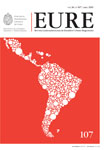Patrones de movilidad residencial en la Ciudad de México como evidencia de co-localización de población y empleos
DOI:
https://doi.org/10.4067/S0250-71612010000100004Palabras clave:
distribución espacial, estructura urbana, localización, mercado de trabajo, movilidadResumen
El artículo describe la movilidad residencial en la Ciudad de México y encuentra evidencias de un proceso de co-localización entre empleos y vivienda. La metodología empleada se basa en una serie de análisis estadísticos que incluyen una regresión log-log de flujos residenciales entre municipios; y un modelo logístico binomial que predice la probabilidad de cambio residencial, cuando hay cambios en el lugar de trabajo. Concluimos que junto a las características socioeconómicas de las personas que cambian de residencia, existe una clara influencia del lugar de trabajo sobre la elección del lugar de vivienda, que hace de la movilidad residencial un mecanismo social de equilibrio de la estructura urbana.
Descargas
Publicado
Cómo citar
Número
Sección
Licencia
Derechos de autor 2010 Revista EURE - Revista de Estudios Urbano Regionales

Esta obra está bajo una licencia internacional Creative Commons Atribución 4.0.
Al momento de aceptar la publicación de sus artículos, los autores deberán formalizar la cesión de derechos de autor a EURE, según las condiciones establecidas por la Revista.
Ésta establece que el autor autoriza a EURE de manera gratuita, exclusiva e ilimitada a reproducir, editar, publicar, distribuir, publicitar, comercializar y traducir el artículo, a cualquier soporte conocido o por conocer y desarrollar.
Del mismo modo, los autores aseguran que el artículo propuesto es original, no publicado y no propuesto para tal fin a otro medio de difusión.


